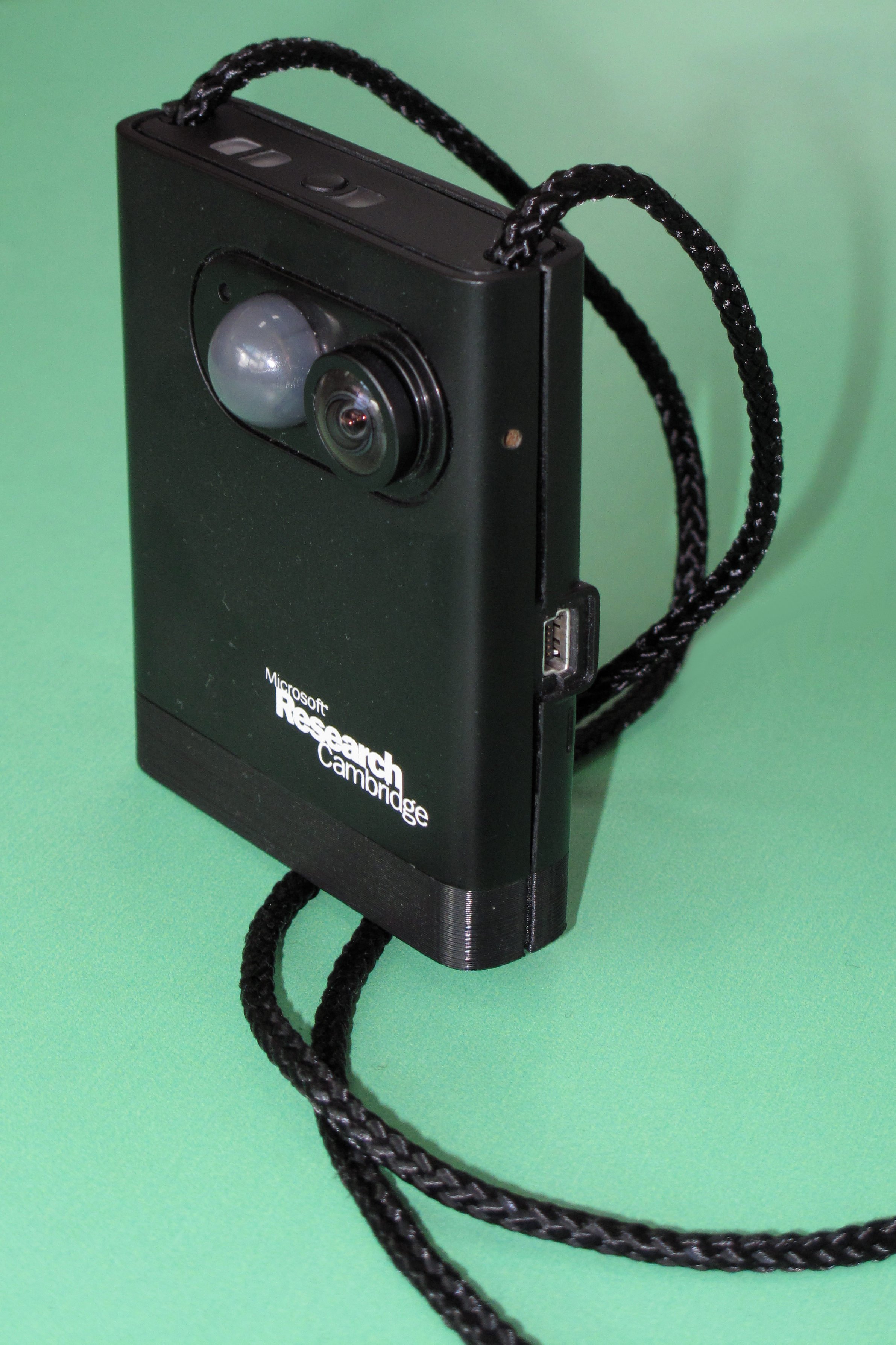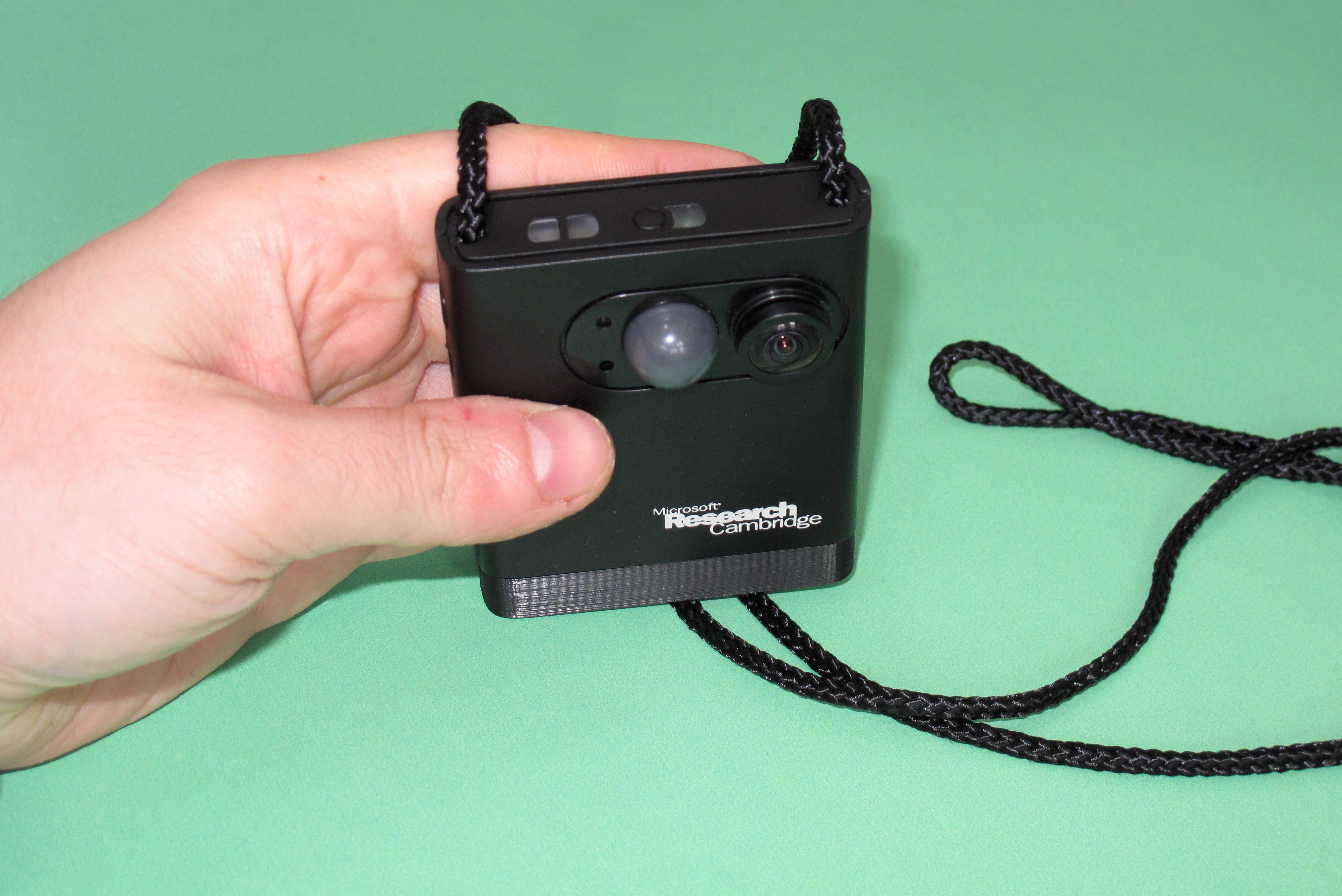Microsoft SenseCam on:
[Wikipedia]
[Google]
[Amazon]

 Microsoft's SenseCam is a
Microsoft's SenseCam is a 
 Wearable neck-worn cameras contribute to an easier way of collecting and indexing one's daily experiences by unobtrusively taking photographs whenever the internal sensor is triggered by a change in temperature, movement, or
Wearable neck-worn cameras contribute to an easier way of collecting and indexing one's daily experiences by unobtrusively taking photographs whenever the internal sensor is triggered by a change in temperature, movement, or
/ref> is also equipped with an accelerometer, which is used to trigger images and can also stabilise images so as to reduce blurriness. The camera is usually worn around the neck via a

SenseCam Applications
/ref>
Microsoft Research Projects: SenseCamSenseCam: A Retrospective Memory AidSenseCam ApplicationsVicon RevueA Personal Perspective on Living Daily Life With A SenseCamAn FAQ About Daily Living With A SenseCam
{{Microsoft Research Microsoft Research Ubiquitous computing Wearable computers

 Microsoft's SenseCam is a
Microsoft's SenseCam is a lifelog
A lifelog is a personal record of one's daily life in a varying amount of detail, for a variety of purposes. The record contains a comprehensive dataset of a human's activities. The data could be used to increase knowledge about how people liv ...
ging camera with fisheye lens
A fisheye lens is an ultra wide-angle lens that produces strong visual distortion intended to create a wide panoramic or hemispherical image. Fisheye lenses achieve extremely wide angles of view, well beyond any rectilinear lens. Instead of pr ...
and trigger sensors, such as accelerometer
An accelerometer is a tool that measures proper acceleration. Proper acceleration is the acceleration (the rate of change of velocity) of a body in its own instantaneous rest frame; this is different from coordinate acceleration, which is accele ...
s, heat sensing, and audio, invented by Lyndsay Williams, patent granted in 2009. Usually worn around the neck, Sensecam is used for the MyLifeBits
MyLifeBits is a life-logging experiment begun in 2001. It is a Microsoft Research project inspired by Vannevar Bush's hypothetical Memex computer system. The project includes full-text search, text and audio annotations, and hyperlinks. The "exper ...
project, a lifetime storage database. Early developers were James Srinivasan and Trevor Taylor.
Earlier work on neck-worn sensor cameras with fisheye lenses was done by Steve Mann, and published in 2001.
Microsoft Sensecam as well as Mann's earlier sensor cameras, and subsequent similar products like Autographer, Glogger and the Narrative Clip
The Narrative Clip is a small wearable lifelogging camera. Its development began in 2012 by the Swedish company Memoto after a successful crowd funding via Kickstarter. It can automatically take a picture every 30 seconds whilst being worn throug ...
, are all examples of Wearable Computing
A wearable computer, also known as a body-borne computer, is a computing device worn on the body. The definition of 'wearable computer' may be narrow or broad, extending to smartphones or even ordinary wristwatches.
Wearables may be for general ...
.

 Wearable neck-worn cameras contribute to an easier way of collecting and indexing one's daily experiences by unobtrusively taking photographs whenever the internal sensor is triggered by a change in temperature, movement, or
Wearable neck-worn cameras contribute to an easier way of collecting and indexing one's daily experiences by unobtrusively taking photographs whenever the internal sensor is triggered by a change in temperature, movement, or lighting
Lighting or illumination is the deliberate use of light to achieve practical or aesthetic effects. Lighting includes the use of both artificial light sources like lamps and light fixtures, as well as natural illumination by capturing daylig ...
. The SensecamSenseCam/ref> is also equipped with an accelerometer, which is used to trigger images and can also stabilise images so as to reduce blurriness. The camera is usually worn around the neck via a
lanyard
A lanyard is a cord, length of webbing, or strap that may serve any of various functions, which include a means of attachment, restraint, retrieval, and activation and deactivation. A lanyard is also a piece of rigging used to secure or lower ...
.
The photos represent almost every experience of its wearer's day. They are taken via a wide-angle lens in order to capture an image that is likely to contain most of what the wearer can see. The SenseCam uses a flash memory
Flash memory is an electronic non-volatile computer memory storage medium that can be electrically erased and reprogrammed. The two main types of flash memory, NOR flash and NAND flash, are named for the NOR and NAND logic gates. Both us ...
which has the means to store upwards of 2,000 photos per day as .jpg files, though more recent models with larger and faster memory cards mean a wearer typically stores up to 4,000 images per day. These files can then be uploaded and automatically viewed as a daily movie, which can be easily reviewed and indexed using a custom viewer application running on a PC. It is possible to replay the images from a single day in as little as a few minutes. An alternative way of viewing images is to have a day's worth of data automatically segmented into 'events' and to use an event-based browser which can view each event (of 50, 100 or more individual SenseCam images) using a keyframe chosen as a representative of that event.
SenseCams have mostly been used in medical applications, particularly to aid those with poor memory as a result of disease or brain trauma. Several studies have been published by Chris Moulin
Chris Moulin is professor at the Laboratoire de Psychologie et NeuroCognition (LPNC UMR 5105), Université Grenoble Alpes, and a senior member of the Institut Universitaire de France.
Moulin is a cognitive neuropsychologist known for his work i ...
, Aiden R. Doherty and Alan F. Smeaton showing how reviewing one's SenseCam images can lead to what Martin A. Conway, a memory researcher from the University of Leeds, calls "Proustian moments", characterised as floods of recalled details of some event in the past. SenseCams have also been used in lifelogging, and one researcher at Dublin City University, Ireland, has been wearing a SenseCam for most of his waking hours, since 2006, and has generated over 13 million SenseCam images of his life.
In October 2009, SenseCam technology was adopted by Vicon Revue and is now available as a product.
There is a wiki dedicated to SenseCam technical issues, software, news, and various research activities and publications about, and using, SenseCam.
Projections

Microsoft Research
Microsoft Research (MSR) is the research subsidiary of Microsoft. It was created in 1991 by Richard Rashid, Bill Gates and Nathan Myhrvold with the intent to advance state-of-the-art computing and solve difficult world problems through technologi ...
has contributed a device that will aid lifebloggers among several other potential users. SenseCam was first developed to help people with memory loss
Amnesia is a deficit in memory caused by brain damage or disease,Gazzaniga, M., Ivry, R., & Mangun, G. (2009) Cognitive Neuroscience: The biology of the mind. New York: W.W. Norton & Company. but it can also be caused temporarily by the use o ...
, but the camera is currently being tested to aid those with serious cognitive memory loss. The SenseCam produces images which are very similar to one's memory, particularly episodic memory
Episodic memory is the memory of everyday events (such as times, location geography, associated emotions, and other contextual information) that can be explicitly stated or conjured. It is the collection of past personal experiences that occurred ...
, which is usually in the form of visual imagery. By reviewing the day's filmstrip, patients with Alzheimer's, amnesia, and other memory impairments found it much easier to retrieve lost memories.
Microsoft Research has also tested internal audio level detection and audio recording for the SenseCam, although there are no plans to build these into the research prototypes at the moment. The research team is also exploring the potential of including sensors that will monitor the wearer's heart-rate, body temperature, and other physiological changes along with an electrocardiogram recorder when capturing pictures.
Other possible applications include using the camera's records for ethnographic studies in social phenomena, monitoring food intake, and assessing an environment's accessibility for people with disabilities./ref>
See also
*Gordon Bell
Chester Gordon Bell (born August 19, 1934) is an American electrical engineer and manager. An early employee of Digital Equipment Corporation (DEC) 1960–1966, Bell designed several of their PDP machines and later became Vice President of Engi ...
* Cathal Gurrin
Cathal Gurrin is an Irish Professor and lifelogger. He is the Head of the Adapt Centre at Dublin City University, a Funded Investigator of the Insight Centre, and the director of the Human Media Archives research group. He was previously the ...
* The Circle (Eggers novel)
''The Circle'' is a 2013 dystopian novel written by American author Dave Eggers. The novel chronicles tech worker Mae Holland as she joins a powerful Internet company. Her initially rewarding experience turns darker.
Plot summary
Mae Holland, ...
References
Further reading
Microsoft Research Projects: SenseCam
{{Microsoft Research Microsoft Research Ubiquitous computing Wearable computers